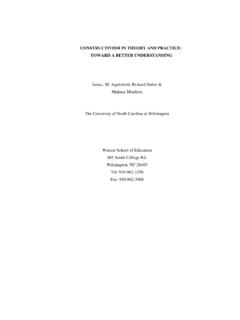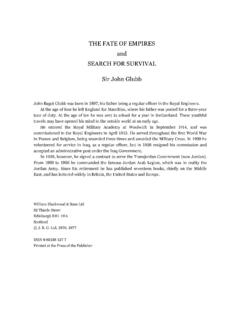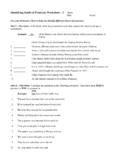Transcription of Brief History of Special Effects in Film
1 Digital Special Effects 475/492. Fall 2006. Brief History of Special Effects in Film Early years, 1890s. Birth of cinema -- 1895, Paris, Lumiere brothers. Cinematographe. Earlier, 1890, .Dickson, assistant to Edison, developed Kinetograph. One of these films included the world's first known Special effect shot, The Execution of Mary, Queen of Scots, by Alfred Clarke, 1895. Georges Melies Father of Special Effects Son of boot-maker, purchased Theatre Robert-Houdin in Paris, produced stage illusions and such as Magic Lantern shows. Witnessed one of first Lumiere shows, and within three months purchased a device for use with Edison's Kinetoscope, and developed his own prototype camera.
2 Produced one-shot films, moving versions of earlier shows, accidentally discovering stop-action for himself. Soon using stop-action, double exposure, fast and slow motion, dissolves, and perspective tricks. Georges Melies Cinderella, 1899, stop-action turns pumpkin into stage coach and rags into a gown. Indian Rubber Head, 1902, uses split-screen by masking areas of film and exposing again, exploding his own head. A Trip to the Moon, 1902, based on Verne and Wells -- 21 minute epic, trompe l'oeil, perspective shifts, and other tricks to tell story of Victorian explorers visiting the moon. Ten-year run as best-known filmmaker, but surpassed by others such as Griffith and bankrupted by WW I.
3 Other Effects Pioneers, early 1900s. Robert W. Paul -- copied Edison's projector and built his own camera and projection system to sell in England. Produced films to sell systems, such as The Haunted Curiosity Shop (1901) and The ? Motorist (1906). Few survived, since he sold his studio and burned his films. Englishman Smith constructed his own movie camera, patenting double-exposure in England, using the method to make a ghost for The Corsican Brothers (1909). Airship Destroyer (1919) used a realistic model of London to create an air attack on the city. 1898, Albert Smith and J. Stuart Blackton, formed Vitagraph, and filmed The Battle of Santiago Bay using paintings and photographs.
4 In The Windsor Hotel Fire (1899), miniatures fell from cardboard buildings with squirt guns simulating the fire department's efforts Other studios: Biograph, Lubin, Selig and Edison -- mimicked recent events such as the 1906 San Francisco earthquake. Edwin Used tricks to further plot rather than for spectacle. S. Porter The Great Train Robbery (1903). - double exposure for train in window and passing landscape. - three frames tinted red to simulate gun being fired, Left Edison in 1909 to head Rex. Moved into research and development but devastated by later used in 1945 by 1929 market crash. Hitchcock for Spellbound.
5 1910s American Industry in SoCal. David Wark Griffith joined Biograph in 1907. and began to revolutionize film grammar with editing, camera movement, shot composition, and lighting. Dissolves, hand-cranking (fast slow v 16. fps), and iris Effects in-camera. 1912 Bell & Howell facilitated split-screens and double exposures with fixed registration pin and accurate frame counter. Norman O. Dawn -- Hollywood's 1st Effects man -- glass shot and in-camera matte shot. 1916 - Frank Williams invents traveling matte system, later refined as blue-screen. Mark Sennett -- Keystone Kops. Gags requiring Effects -- rubber bricks, collapsing telegraph poles, fake houses, car crashes, Special patrol wagon.
6 Chaplin, Llloyd, and even Capra worked here at one time. Special effect received first screen credit in 1920s 1926 Fox picture What Price Glory? Continued use of traveling mattes, placing actors filmed in studio placed within settings of a different time and place. Use of miniatures such as in The Crowd (1928). and Just Imagine (1930). Dominance of German filmmakers in Effects work such as Paul Wegener: Living Buddhas (1923). Fritz Lang: Die Niebelungen (1924) 60 ft dragon, Shuftan process combining full- size sets with miniatures using mirrors. Metropolis (1926) -- models, animation, matte painting, rear projection, and full.
7 Scale mechanical Effects . US: By Rocket to the Moon America tried to compete with opulent sets such as used in Thief of Bagdad (1924). Wires Linwood Dunn, RKO, optical printer. for the flying carpet. 1930s James Whale, Frankenstein (1931), electrical Effects by Kenneth Strickfaden. Model work by John P. Fulton. Invisible Man (1934). Merian C. Cooper and animator Willis O'Brien -- King Kong (1933) -- stop- motion, miniatures, rear-projection, and optical compositing using live actors, puppets, and miniatures. 55 weeks for stop-motion. Departments such as at MGM: Special Effects -- rear projection, miniatures, and physical Effects .
8 Optical dept -- matte paintings and optical printing. 1939 -- first Academy Award in Special Effects given to The Rains Came . featuring a tremendous flood, besting Gone with the Wind and Wizard of Oz. 1940s Citizen Kane (1941) -- matte paintings, miniatures, and advanced optical printing (not even nominated). Color film required many modifications to learned techniques. Gone With the Wind (1939) first Technicolor matte painting. Hitchcock less often credited as important sfx director began US. career with Rebecca (1940). Willis O'Brien directed Mighty Joe Young with assistance by young Ray Harryhausen who went on to create more than 20 films such as Jason and the Argonauts and Sinbad and Color traveling mattes first used in the 1940.
9 The Eye of the Tiger. film The Thief of Baghdad. 1950s Paramount invents repeater', early mechanical motion control. Movie attendance drops as television grows. Effects -laden productions and larger-than- life formats such as CinemaScope, VistaVision, Cinerama, and 3-D. The Robe 1953, first CinemaScope film. Destination Moon, The War of the Worlds (1953), George Pal. The 7th Voyage of Sinbad (1959) -- Harryhausen used perspective, splitscreen, improportional props, mattes, and stop- motion. Cecil B. DeMille's The Ten Commandments -- blue screen, miniatures, pyrotechnics, 600. extras, matte paintings, 32-foot high dam.
10 1960s Effects departments shut down, except for Disney -- The Nutty Professor and Mary Poppins. Extravagant budgets, sets, use of extras, costume, etc. in large and more violent productions to lure more audience after thousands of theater-closures. Ivan Sutherland invents Sketchpad in 1961. Cleopatra (1963). $44 million (approx $300. million today). Roman forum larger than original. Full-scale barge with gilded stern. Fantastic Voyage (1966) enormous sets and wire- suspended actors. Planet of the Apes (1968). Kubrick's 2001: A Space Odyssey (1968), early motion control, slit-scan technique for Stargate corridor, miniatures, front projection, etc.















